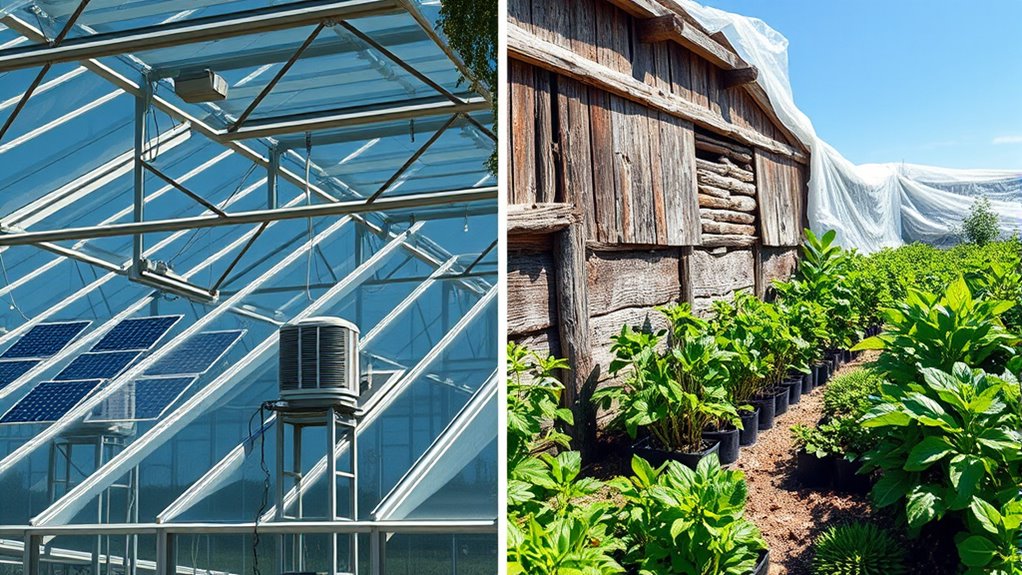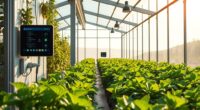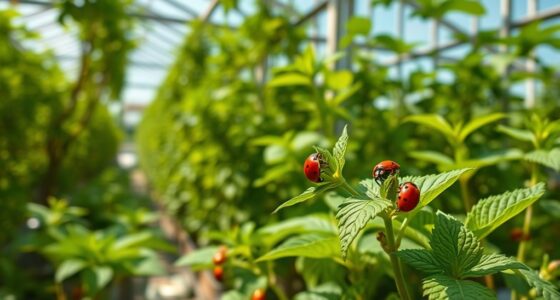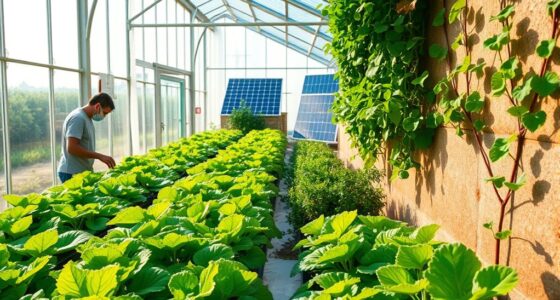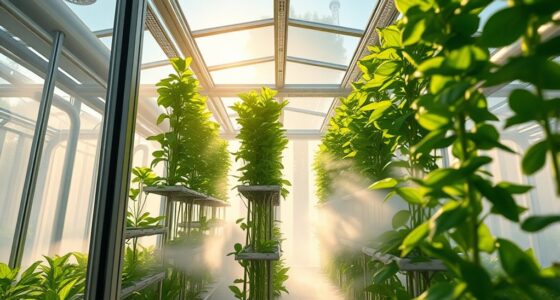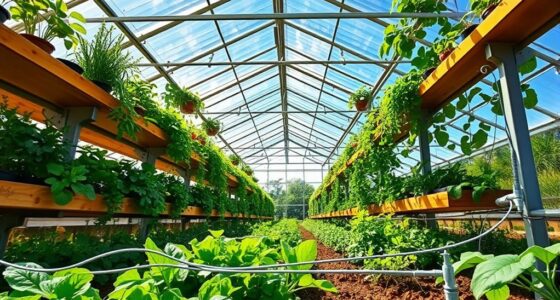Choosing between high-tech and low-tech greenhouse methods depends on your goals, budget, and scale. High-tech solutions, like automation and climate control, boost yields and efficiency but require a larger initial investment. Low-tech approaches are more affordable and flexible, making them ideal for small-scale or beginner growers. Combining both strategies can optimize production and adapt to changing conditions. To discover how you can balance these options effectively, keep exploring the options available to you.
Key Takeaways
- High-tech systems maximize efficiency and yields through automation but require significant upfront investment and infrastructure.
- Low-tech methods are cost-effective, flexible, and suitable for small-scale or beginner growers with less capital.
- Combining both approaches allows tailored management, balancing automation benefits with manual adaptability.
- Large-scale commercial operations benefit from high-tech automation for consistency, while small farms may prioritize low-tech options.
- Consider your budget, scale, environmental control needs, and long-term goals when choosing between high-tech and low-tech greenhouse approaches.
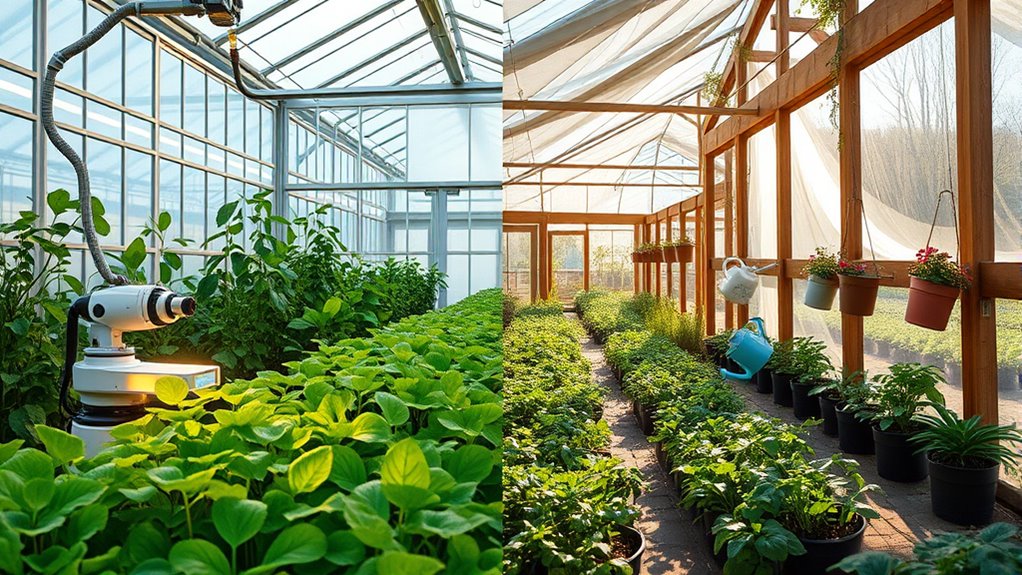
When it comes to greenhouse farming, choosing between high-tech and low-tech approaches can considerably impact your yields, costs, and sustainability. If you’re considering automation systems, you might lean toward high-tech solutions that streamline operations, reduce labor, and optimize growing conditions. These systems can include automated watering, climate control, and nutrient delivery, making it easier to maintain precise environmental parameters. By integrating sensors and software, you get real-time data that helps you make informed decisions, leading to higher productivity and less resource waste. On the other hand, if you’re more comfortable with manual cultivation, you might prefer a low-tech approach that relies on traditional techniques and hands-on management. This method often involves less upfront investment, giving you more control over every step of the growing process. It also allows you to adapt quickly to changes without relying on complex machinery or software, which can be advantageous in certain climates or for smaller-scale operations.
The choice largely depends on your budget, scale, and goals. High-tech systems demand significant initial capital but can pay off through increased efficiency and reduced labor costs over time. Automation can handle repetitive tasks more reliably, freeing you to focus on planning, research, or expansion. Additionally, considering automation options and their compatibility with your existing infrastructure can help you make more informed decisions. Incorporating climate control systems can also optimize environmental conditions for different crop types, improving overall yields. Consider your long-term vision. If you aim for large-scale, highly consistent production, investing in automation systems makes sense. They help maximize yields and ensure uniformity, which is indispensable for commercial success. If you’re just starting out, experimenting with low-tech methods can be more manageable and educational, helping you understand your crops’ specific needs without heavy investments. Ultimately, the right approach hinges on balancing your resources, experience, and ambitions. Whether you choose to rely on sophisticated automation or stick with manual cultivation, understanding the strengths and limitations of each will help you make smarter decisions. Remember, combining elements of both can sometimes provide the best of both worlds, allowing you to innovate while staying grounded in proven techniques.
Frequently Asked Questions
What Are the Initial Costs for High-Tech Versus Low-Tech Greenhouses?
When comparing initial costs, you’ll find that high-tech greenhouses require a bigger upfront investment due to advanced automation and climate control systems. Low-tech options have lower initial costs, making them more accessible if you’re on a budget. Conducting a cost comparison helps with your investment analysis, so you can weigh the long-term benefits against the initial expenses. Ultimately, your choice depends on your budget and productivity goals.
How Do Maintenance Requirements Differ Between High-Tech and Low-Tech Options?
You’ll find that high-tech greenhouses often require less manual labor because automation handles many tasks, though they come with automation challenges that need ongoing attention. In contrast, low-tech options demand more manual labor, making maintenance straightforward but labor-intensive. While high-tech systems need regular checks for equipment and software, low-tech greenhouses need consistent physical maintenance, so your choice affects ongoing maintenance demands and the level of automation challenges you face daily.
Which Greenhouse Approach Offers Better Long-Term Sustainability?
You want a greener future, so you ask which approach is more sustainable. Both options can be effective, but a high-tech greenhouse often integrates renewable energy sources and maximizes resource efficiency, making it more sustainable long-term. Low-tech systems can be sustainable too, but they may rely more on natural resources and less on energy innovation. Ultimately, choosing a high-tech approach can enhance sustainability through smarter resource use and renewable energy integration.
Can Low-Tech Greenhouses Be Upgraded to High-Tech Systems Later?
Yes, you can retrofit a low-tech greenhouse to add high-tech features later. Focus on greenhouse retrofitting to upgrade systems like automation, climate control, and irrigation. This approach allows you to enhance technology scalability gradually, making your greenhouse more efficient over time. Planning ahead guarantees the structure supports new equipment, making shifts smoother and cost-effective while boosting productivity and sustainability.
How Do Climate Conditions Influence the Choice Between High-Tech and Low-Tech?
Climate conditions play a vital role in your greenhouse choice. If your environment requires climate adaptation, high-tech systems offer precise control and optimize growth despite fluctuations. Conversely, low-tech greenhouses suit stable climates, reducing environmental impact and energy use. You should consider your local weather patterns, resource availability, and sustainability goals to choose the best approach. Ultimately, climate influences efficiency, cost, and environmental footprint of your greenhouse operation.
Conclusion
Choosing between high-tech and low-tech greenhouses depends on your goals and resources. Did you know that high-tech greenhouses can boost crop yields by up to 30% compared to traditional setups? If you want increased efficiency and precision, investing in advanced technology might be worth it. However, low-tech options remain accessible and sustainable for many. Ultimately, your choice should align with your budget, expertise, and environmental values to guarantee a thriving greenhouse.
